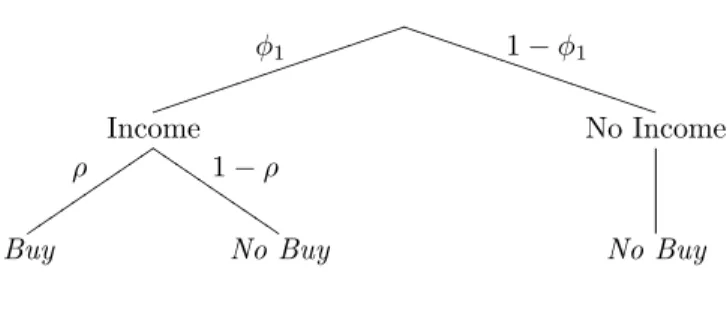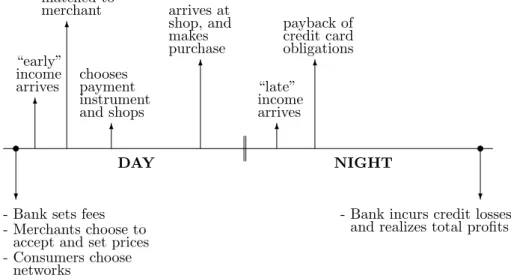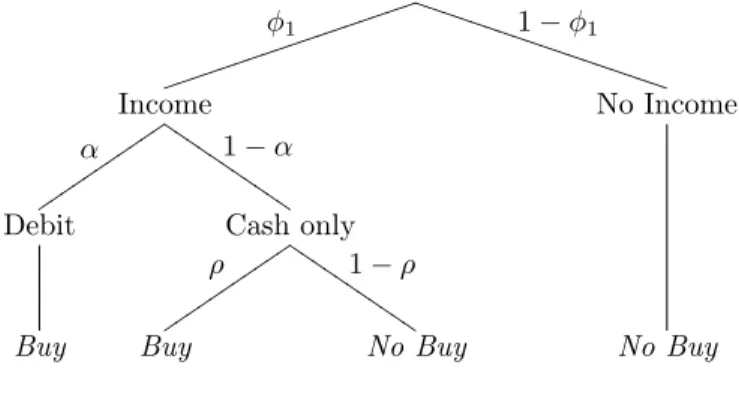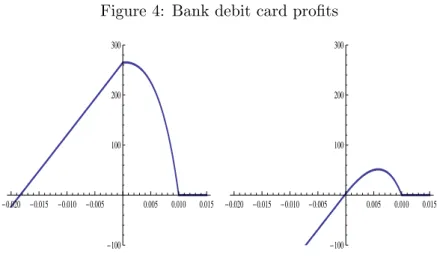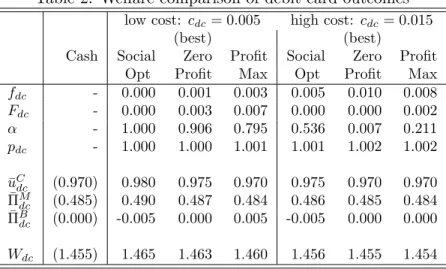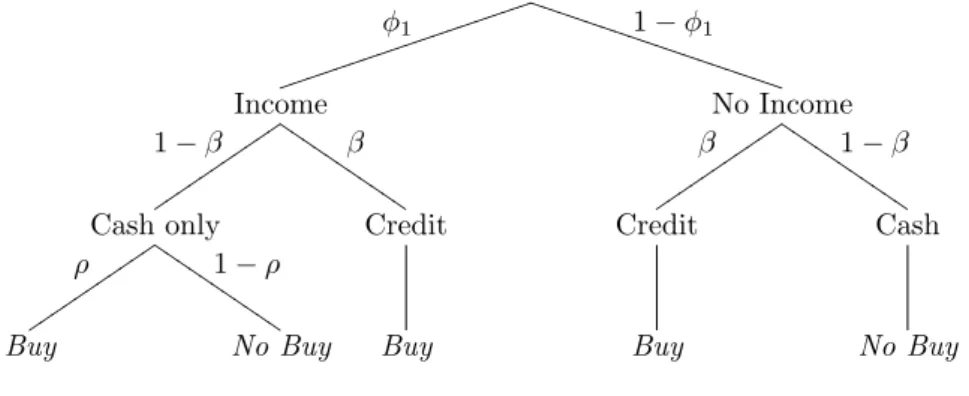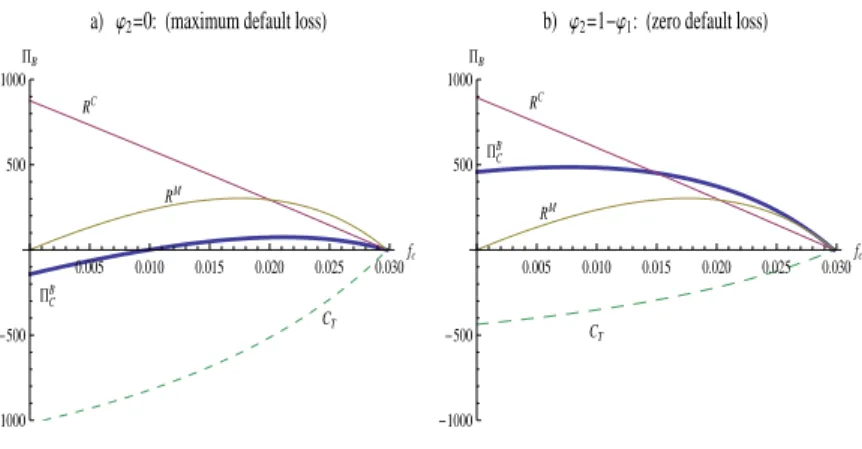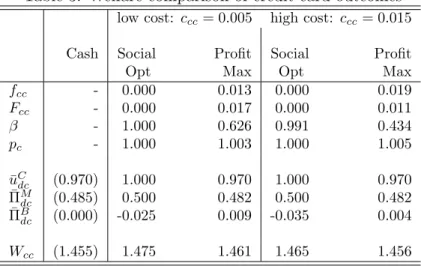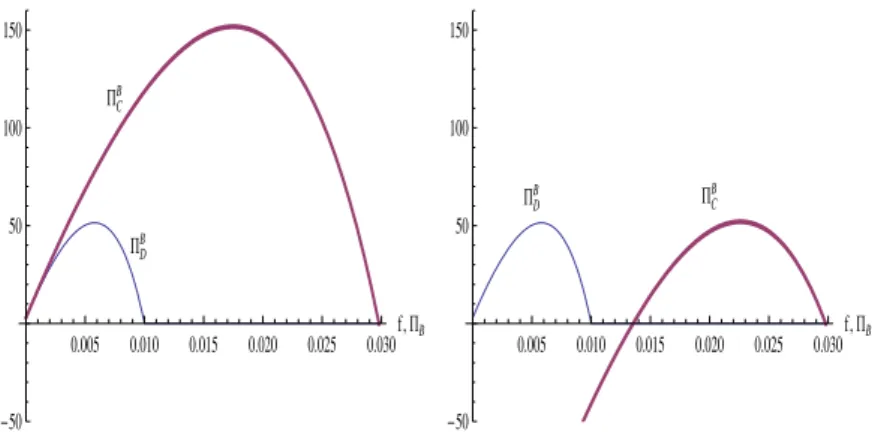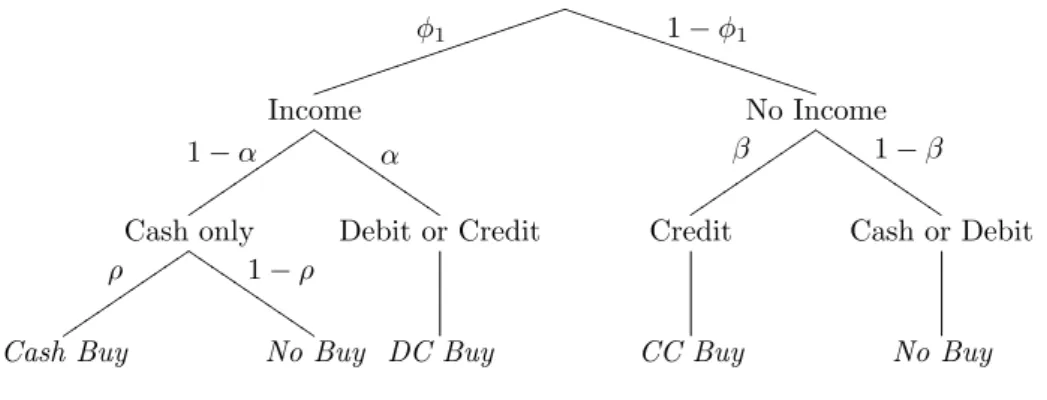Federal Reserve Bank of Chicago
Consumer Choice and Merchant
Acceptance of Payment Media
Wilko Bolt and Sujit Chakravorti
Consumer Choice and Merchant Acceptance of Payment Media
Wilko Bolt Sujit Chakravorti∗November 26, 2008
Abstract
We study the ability of banks and merchants to influence the consumer’s payment instrument choice. Consumers participate in payment card networks to insure them-selves against three types of shocks— income, theft, and their merchant match. Mer-chants choose which payment instruments to accept based on their production costs and increased profit opportunities. Our key results can be summarized as follows. The struc-ture of prices is determined by the level of the bank’s cost to provide payment services including the level of aggregate credit loss, the probability of theft, and the timing of income flows. We also identify equilibria where the bank finds it profitable to offer one or both payment cards. Our model predicts that when merchants are restricted to charging a uniform price for goods that they sell, the bank benefits while consumers and mer-chants are worse off. Finally, we compare welfare-maximizing price structures to those that result from the bank’s profit-maximizing price structure.
Key Words: Retail Financial Services, Network Effects, Social Welfare, Multihoming, Payment Card Networks
JEL Codes: L11, G21, D53
∗Bolt can be reached at w.bolt@dnb.nl and Chakravorti can be reached at sujit.chakravorti@chi.frb.org. We thank Gadi Barlevy, Jeff Campbell, Anneke Kosse, Cyril Monnet, Derek Neal, Henri Pages, and seminar participants at the Market for Retail Financial Services: Development, Integration, and Economic Effects held at the Czech National Bank, the Payment Economics III conference held at the Federal Reserve Bank of Atlanta, Workshop on Payment Economics at the Bank of Canada, De Nederlandsche Bank, the European Central Bank, the Federal Reserve Bank of Chicago, the Riksbank, and the University of Granada. The views expressed are those of the authors and do not represent the views of De Nederlandsche Bank, the Federal Reserve Bank of Chicago or the Federal Reserve System.
1
Introduction
Over the last two decades, consumer usage and merchant acceptance of payment cards have increased in advanced economies while cash and check usage has declined (Amromin and Chakravorti, 2009, and Humphrey, 2004). Many observers argue that movement away from paper-based payment instruments to electronic ones such as payment cards has increased overall payment system efficiency. However, policymakers in various jurisdictions have ques-tioned the pricing of payment card services.1 The U.S. Congress is considering legislation that would grant antitrust immunity to merchants to collectively negotiate fees with payment providers. The European Commission prohibited MasterCard from imposing interchange fees, the fee that the merchant’s bank pays the cardholder’s bank, for cross-border European payment card transactions. Some public authorities around the world have removed restric-tions by payment networks that prevent merchants from setting prices for goods and services based on the payment instrument used.
We construct a model in the spirit of Diamond and Dybvig (1983) that analyzes the pricing decision of banks in the provision of payment instruments to maximize profits in a two-sided market. A market is said to be two-sided if two distinct sets of end-users are unable to negotiate prices and the prices charged to each end-user affects the allocation of goods or services (Armstrong, 2005 and Rochet and Tirole, 2006). Our model differs from the existing literature in the following ways. For the most part, the recent payment card literature has used a reduced form approach when considering the costs and benefits of payment cards.2 In our model, consumers participate in non-cash payment networks to insure themselves from three types of shocks– income, theft, and the type of merchant that they are matched to. In other words, consumers benefit from consumption in states of the world that would not be possible without payment cards. Consumers are willing to pay a fixed fee as long as their expected utility when they participate in a card network is at least as great as their expected utility if they only use cash. Furthermore, acceptance of payment cards may increase merchant profits resulting from increased sales. Merchants trade off increased profits against additional payment costs in the forms of merchant card fees. Ultimately, optimal bank fees
1Bradford and Hayashi (2008) provide a summary of scrutiny of public authorities and courts in various
countries.
2Chakravorti and Emmons (2003), Chakravorti and To (2007), and McAndrews and Wang (2006) are
are functions of the probability of getting mugged, the timing of consumer income flows, merchant costs and pass-through, bank payment processing costs, and the level of aggregate credit loss.
Our main results can be summarized as follows. We derive conditions when merchants accept one, two, or three payment instruments based on their costs and their ability to pass on payment processing costs to consumers. The bank fully extracts consumer surplus before the bank levies merchant fees. Merchant inability to pass on payment cost increases bank profit, since cost absorption by merchants leads to lower goods prices and higher consumer revenues. Depending on card processing and default costs, banks may have an incentive to simultaneously supply debit and credit cards. For relatively low credit card costs, the bank would refrain from supplying debit cards and only offer credit card services. The bank’s profit-maximizing merchant fees are equal to or higher than the socially optimal fees for debit cards and are always higher for credit cards. A social planner internalises the positive network effects of increased merchant acceptance by setting lower merchant fees. Some welfare-maximizing price structures may result in negative bank profit. In these cases, the social planner always sets zero fixed fees for consumers to fully maximize additional consumption and merchant sales in the economy. However, if bank profits are restricted to be zero, different price structures emerge where both consumers and merchants pay positive fees. Finally, bank profit is higher when merchants are restricted from setting instrument-contingent pricing.
In the next section, we briefly summarize the payment card literature. In section 3, we describe the environment, agents, and payment technologies. We consider economies with debit and credit cards in sections 4 and 5, respectively. We explore an economy where all three instruments exist in section 6 and conclude in section 7.
2
Literature Review
Payment card networks consist of three types of players–consumers, merchants, and financial institutions– that participate in a payment network. Consumers establish relationships with financial institutions so that they can make payments that access funds from their accounts or utilize credit facilities. They may be charged fixed fees in addition to finance charges if they borrow for an extended period of time. For consumers to use payment cards, merchants must
accept them. Merchants establish relationships with financial institutions to convert card payments into bank deposits and are generally charged per-transaction fees. Generally, the merchant’s bank, the acquirer, pays an interchange fee to the cardholder’s bank, the issuer. The underlying payment fee structure is determined by the interrelated bilateral relationships among the players, their bargaining power, and the ability of the network to maximize profits for its members.
The payment card literature can be separated into four strands.3 The first strand focuses on the interchange fee and whether the payment providers’ profit-maximizing fee is lower or higher than the socially optimal interchange fee. The second strand focuses on the ability of merchants to separate card and cash users by using instrument-contingent prices. The third strand considers the effect of platform competition on the structure of prices. The fourth strand considers the role of credit and its benefits to consumers and merchants. Some research incorporates multiple strands but none to date has been able to include all four.
While most of the payment card literature started a decade or so ago, Baxter (1983) be-gan the theoretical literature on payment cards. In his model, consumers are homogenous, merchants are perfectly competitive, and issuers and acquirers operate in competitive mar-kets. He found that the interchange fee balances the demands of consumers and merchants and improves consumer and merchant welfare. Research that built upon Baxter relaxed the assumptions of competitive markets for consumption goods and payment services and introduced strategic interactions among consumers and merchants. Schamalensee (2002) considers an environment where issuers and acquirers have market power and finds that the profit-maximizing interchange fee may be the same as the socially optimal one. Rochet and Tirole introduce merchant competition and consumer heterogeneity and find that business stealing may result in the profit-maximizing interchange fee being higher than the socially optimal one. Wright (2004) finds that introducing merchant heterogeneity results in the profit-maximizing interchange fee being potentially above or below the socially optimally one.
For the most part, these models ignore the ability of merchants to steer consumers by imposing instrument-contingent pricing. Carlton and Frankel (1995) argue that if merchants are able to set instrument-contingent pricing, the interchange fee would be neutral. The
interchange fee is said to be neutral if a change in the fee does not change the quantity of consumer purchases and the level of merchant and bank profits. Several authors have formalized this result. Gans and King (2003) find that if payment separation is achieved, the interchange fee is neutral. Payment separation occurs in competitive markets where merchants separate into cash and card stores or if monopolist merchants impose instrument-contingent pricing. Schwartz and Vincent (2006) find that uniform prices harm cash users and merchants, and may worsen overall consumer welfare. A key assumption in this strand of the literature is that if there is pass-through of payment processing fees, merchants are able to fully pass on their payment processing costs.
The payment card literature has also considered competition among payment networks. Rochet and Tirole (2003) and Guthrie and Wright (2007) find that network competition does not necessarily improve the structure of prices. Chakravorti and Rosen (2006) confirm this result but also find cases where the reduction in the total price improves overall welfare even when the resulting price structure is welfare dominated by the price structure when only one network exists.
The models discussed so far did not consider an increase in total consumption result-ing from payment card adoption. Chakravorti and Emmons (2003) and Chakravorti and To (2007) focus on a key aspect of certain types of payment cards–the extension of credit.4 They construct models where aggregate consumption increases because credit cards enable consumers without funds to purchase goods benefitting both consumers and merchants. Chakravorti and Emmons find that illiquid consumers are willing to finance the payment card network. They also find that payment separation improves welfare by eliminating sub-sidies to convenience users–those that do not need credit to make purchases. Chakravorti and To demonstrate that merchants are willing to bear the cost of higher credit risk if their sales increase. However, these models do not endogenously solve for the optimal price structure between the two types of end-users.
In this article, we combine elements of all four strands of the literature by stressing price structure in an environment where two types of payment cards may improve consumer and merchant welfare. Specifically, debit cards offer consumers protection against theft. While
4While the most common form of payment cards that extend credit are credit cards, debit card issuers in
some countries allow their customers to access overdraft facilities. Generally, when debit card users access overdraft facilities, they bear almost all of the cost of the credit extension.
credit cards offer theft protection, they also insure against income shocks unlike debit cards. We study the ability of merchants to steer consumers by imposing instrument-contingent pricing to achieve an equilibrium where they can separate consumers into those that have funds from those that do not.
3
A Model of Payment Cards
3.1 Environment and Agents
There are three types of agents– consumers, merchants, and a monopolist bank. In our model, we have combined the issuer and acquirer into one entity so as to abstract from the interchange fee decision between issuers and acquirers.5 All agents are risk neutral.6 A continuum of ex ante identical consumers reside on a line segment from 0 to 1. A continuum of monopolist merchants reside on a line segment from 0 to 1 differentiated by the type of good and the cost that they face to serve each customer.
Consumers are subject to three shocks. First, consumers either receive income, I, in the morning with probability, φ1, or at night with probability, φ2, or no income at all with probability, 1−φ1 −φ2, where φ1 +φ2 ≤ 1. These probabilities are given exogenously. Second, before leaving home, each consumer is randomly matched to a merchant selling a unique good. Third, a cash-carrying consumer may also be mugged in transit to the merchant with probability 1−ρ resulting in complete loss of income (and consumption).7
Consumers maximize expected utility. For computational ease, we make the following assumptions about consumers. First, we assume a linear utility function u(x) =x. Second, consumers only have positive utility when consuming goods sold by the merchant they are matched to. Third, each consumer spends all her income during the day because she receives no utility from unused income after that.
Merchant heterogeneity is based on the type of good that they sell and their cost. Each merchant faces a unique exogenously given cost,γi. Merchant costs are uniformly distributed 5A four-party network is mathematically equivalent to a three-party network when issuing or acquiring is
perfectly competitive. In that case, the optimal interchange fee is directly derived from the optimal consumer and merchant fee (e.g. Bolt, 2006).
6Our qualitative results would not change if consumers and merchants were risk averse. In fact, consumers
and merchants would be willing to pay more to participate in payment card networks.
7He, Huang, and Wright (2005) construct a search model of money and banking that endogenizes the
on a line segment from 0 to 1.8 Although merchants face different costs, each merchant sells its good at pm. For convenience, this price is set to 1. We make this assumption to capture
merchant pricing power heterogeneity in the economy in a tractable model. In other words, this assumption reflects that different merchants have different mark-ups across the economy. The per customer (expected) profit of merchant iwhen accepting cash, Πi
m, is:
Πim=φ1ρ(1−γi)I.
In a cash-only economy, consumers cannot consume if they are mugged on the way to the merchant or if their income arrives at night.9 In figure 1, the probability tree for the cash economy is diagrammed. As a benchmark, in a cash-only environment, the expected consumption of a consumer is:
¯
uCm =E[u(I)] =φ1ρI, and the average merchant profit is:
¯
ΠMm =E[Πim] = φ1ρI 2 . The bank makes no profit in a cash-only economy, ¯ΠB
m= 0.
Expected total welfare is derived by summing up expected consumer utility, expected merchant profits and expected bank profits. Specifically, in a cash-only environment, total welfare is given by:
Wm= ¯uCm+ ¯ΠmM + ¯ΠBm= 3φ1ρI 2 .
3.2 Alternative Payment Technologies
The monopolist bank provides two types of payment instruments– debit cards and credit cards.10 Debit cards offer consumers protection from theft and credit cards offer protection against theft and income shocks. The supply of debit and credit card services by the bank
8We would expect our results to be robust to different distributions of merchant costs.
9We do not model the role of a central bank in providing fiat money and the implications on price level.
An alternative interpretation of cash in our model is to assume that consumers receive income in the form of a good that merchants consume.
10On average, the bank is endowedφ
Figure 1: Probability tree for cash φ1 jjjjjjjj jjjjjjjj jj 1−φ1 T T T T T T T T T T T T T T T T T T Income ρ uuuuuu uuuuu 1−ρ I I I I I I I I I I I No Income
Buy No Buy No Buy
increases the additional states of the world where consumption occurs. For convenience, we assume that the bank charges non-negative payment fees to consumers and merchants.11
Consumers that choose to participate in a debit or credit card network sign fully en-forceable contracts where their incomes are directly deposited into their bank accounts when realized. The bank provides access to cash at no charge, but charges consumers membership fees to use debit cards, Fdc ≥ 0, and credit cards, Fcc ≥ 0, that are deducted from their
payroll deposits upon arrival.12 We denote F
T as the total fixed fee charged to consumers
for participation in both networks. The bank sets merchant per-transaction fees,fdc ≥0 and
fcc ≥0, for debit and credit card transactions, respectively.13 In reality, different merchants
face different fees for payment services. For convenience, we only consider one fee for all merchants.14
To maintain tractability and still capture some key characteristics of payments cards, we make the following assumptions about merchant pricing. First, for time consistency reasons, merchants cannot charge higher prices than those they posted when consumers made their decision to join one or more payment networks. Second, we assume that all merchants will post the same price for their goods given the payment instrument used to make the purchase.
11Our model is able to consider negative fees in a straightforward way. However, allowing negative fees
makes the analysis more complex without gaining additional insight. Note, that negative merchant fees do not increase merchant acceptance any further, so that bank profits will only decrease for larger negative fees. Therefore, allowing negative fees will not affect optimal pricing. Only when the pass-through parameter gets very close or equal to zero, the optimal pricing characterization changes.
12Clearly, the bank can use a strategy to price cash as well. We ignore this aspect primarily because of the
complexity of solving a model with six different prices for payment services. However, banks generally do not charge for cash withdrawals from their own automated teller machines in advanced economies.
13This fee structure captures what we observe in many countries. Generally, consumers do not pay
per-transaction fees when using their payment cards, but merchants generally do pay the bulk of their payment service fees on a per-transaction basis.
14However, different merchant fees based on differences in costs would enable greater extraction of merchant
Merchants setpdcfor goods purchased with a debit card and setpcc for goods purchased with
a credit card. Each merchant is unable to fully endogenize the cost of payment processing in terms of the price for its good. In reality, merchants would set prices based on the fee it faces and the demand elasticity of its own customers. However, given our focus to derive payment service fees in a tractable model, we introduce a merchant pricing rule that captures the ability of merchants to pass on payment processing costs to consumers, albeit imperfectly. Note that many merchants do not set instrument-contingent pricing but may set one uniform price. We will consider such merchant pricing later in the paper.
In our model, we consider an exogenous parameter, λj, to capture a continuum of
pass-through from none to complete.15 By separating market power from pass through, we are able to consider industries where profit margins are slim but payment cards are accepted, e.g. discount airlines that often impose credit card surcharges in jurisdictions where they are allowed to do so. We consider the following pricing rule. Let us consider two polar cases– the merchant is unable to pass any payment costs to consumers, pdc =pcc =pm = 1, or is able to pass on all of its cost to consumers, pj = 1/(1−fj),j=dc, cc. The level of pass-through is determined exogenously by λj ∈[0,1]. Thus,pj is given by:
pj(fj) = 1−f 1
j(1−λj), j=dc, cc. (1)
When λj = 1, merchants cannot pass on any payment processing costs in the form of higher
prices to consumers. When λj = 0, merchants are able to pass on all payment processing
costs to consumers.16 If there is complete pass-through of payment costs to merchants in the form of higher prices, the balance of prices does not matter. We assume that merchants are not able to increase their prices beyond the recovery of payment processing costs. For reference, we list the exogenous and endogenous variables that appear in our model in table 1. When participating in payment networks, consumers that received their income in the morning have less disposable income to spend at merchants than in the cash-only economy. Given our assumption of atomistic merchants and no collusion, merchants affect the level of the consumer’s fixed fee. In other words, if all consumers participate in payment card
15The parameterλ
jcan also be interpreted as the bargaining power between consumers and merchants.
Table 1: Variables in the Model Exogenous variables:
I Income for consumer
φ1 Probability of receiving income before shopping φ2 Probability of receiving income after shopping
ρ Probability of not getting robbed when carrying cash γi Merchant-specific cost
pm Price for good if paying by cash
λdc Proportion of debit card merchant fee absorbed by merchants
λcc Proportion of credit card merchant fee absorbed by merchants
cdc Bank’s per-transaction cost to process debit card transaction
ccc Bank’s per-transaction cost to process debit card transaction
Endogenous variables:
α Proportion of merchants accepting debit cards β Proportion of merchants accepting credit cards pdc Price of good if paying with debit card
pcc Price of good if paying with credit card
Fdc Fixed consumer fee for debit card Fcd Fixed consumer fee for credit card
fdc Per-transaction merchant fee for debit card
fcc Per-transaction merchant fee for credit card
networks, aggregate consumer disposable income has also decreased and cash-only merchants would receive less revenue as well. However, there is a tradeoff between a lower level of disposable income and the probability of no sale if the consumer is mugged or does not have funds.
The timing of events is depicted in figure 2. In the early morning, the bank posts its prices for payment services, merchants announce their acceptance of payment products and their prices, and consumers choose which payment networks to participate in. Next, some consumers realize their income and are matched with a specific merchant. Consumers decide which payment instrument to use before leaving home based on the merchant acceptance and their prices. During the day, consumers go shopping. At night, consumers that did not receive income in the morning may receive income and pay back their credit card obligations. The bank faces losses from credit card consumers that never receive income.
Figure 2: Timing of events ? 6 6 6 6 6 6 s s ? DAY NIGHT
- Bank sets fees - Merchants choose to
accept and set prices - Consumers choose networks “early” income arrives matched to merchant chooses payment instrument and shops arrives at shop, and makes purchase “late” income arrives payback of credit card obligations
- Bank incurs credit losses and realizes total profits
4
Cash and Debit Cards
In this section, we will limit our analysis to an economy with cash and debit cards. When compared to cash, debit cards are more secure for consumers to carry than cash because cash-carrying consumers have some probability of being mugged. We endogenously determine the proportion of merchants that accepts debit cards and denote it as α. Because debit cards may not be accepted by all merchants, consumers must use cash for some purchases. In figure 3, we diagram additional states of nature when consumption occurs when debit cards exist. Consumers can consume in an additional α(1−ρ) states of nature.
Consumers are willing to participate in a debit card network if the fixed fee, Fdc, is less
than or equal to the expected utility from additional consumption. In other words, the following inequality must be satisfied:
ρφ1I ≤φ1 µ (1−α)ρ+ α pdc ¶ (I−Fdc).
This inequality yields the maximum debit card fee,Fmax
dc , that consumers are willing to pay
as a function of exogenous parameters, ρ, φ1, and I, and endogenous parameters, α and pdc. Given that consumers must commit to the membership fee before being matched to a merchant, all consumers purchasing from stores that accept debit cards will always use their
Figure 3: Probability tree for debit cards φ1 jjjjjjjj jjjjjjjj jj 1−φ1 T T T T T T T T T T T T T T T T T T Income α uuuuuu uuuuu 1−α I I I I I I I I I I I No Income
Debit Cash only
ρ uuuuuu uuuuu 1−ρ I I I I I I I I I I I
Buy Buy No Buy No Buy
debit cards and leave home without cash, because they face a positive probability of being mugged when carrying cash.
Merchants must make at least as much profit from accepting debit cards than only ac-cepting cash. The merchanti’s (expected) profit from accepting debit cards, Πidc, is:
Πidc=φ1 µ (1−fdc)−pγi dc ¶ (I −Fdc).
Note that by accepting debit cards merchants attract additional sales because of safe transit of consumers. Moreover, merchants can increase their goods price from pm to pdc to offset their cost.
Merchants accept debit cards only when Πi
m ≤Πidc.17 This inequality yields a threshold
cost γdc, below which merchants accept debit cards for payment. Note that cash-only
mer-chants are strictly worse off because consumers that arrive at their stores have less disposible income. Having substituted debit card pricing rule (1) in γdc, the proportion of merchants
willing to accept debit cards is:
α(fdc) =P r[γi ≤γdc] =γdc =
1−fdc−ρ
1−fdc(1−λdc)−ρ. (2) As the degree of pass-through increases, more and more merchants are able to accept debit cards. We observe that α(fdc, ρ, λdc)∈[0,1] if and only iffdc ∈[0,1−ρ] andλdc >0. Note
that if merchants are able to fully pass on costs to consumers (λdc = 0), all merchants will
17Our model does not capture business stealing incentives as a driver for card acceptance. See Rochet and
accept debit cards (α= 1), regardless of the fee.
Lemma 1 The maximum debit card fixed fee, Fmax
dc , is:18 Fdcmax(fdc) = µ 1− ρ 1−fdc ¶ I. (3)
Equation (3) expresses the highest fixed fee, Fmax
dc , that consumers are willing to pay
given the probability of not getting mugged, ρ, and the merchant fee, fdc. The probability
of getting mugged must be greater than or equal to the merchant fee. Furthermore, the consumer fee internalizes the network effect that consumers are willing to pay higher fees when more merchants accept the card. However, this effect is dampened by a potential decrease in purchasing power depending on the degree to which merchants increase their price for debit card purchases. Merchant acceptance of debit cards is higher when fdc is
lower except when there is full pass-through. However, with full pass-through, consumers pay all of the merchants processing costs and must be compensated with a lower fixed fee.
Now, we solve the bank’s profit maximization problem for the consumer and merchant fees. The bank maximizes its expected per-consumer profit:
ΠBdc(Fdc, fdc, α) =φ1(α(fdc−cdc)(I−Fdc)) + (φ1+φ2)Fdc. (4)
Note that the bank only makes money when debit cards are accepted and used, i.e. α >0. A fraction (1−φ1−φ2) of fixed fee revenue is lost, because some consumers never receive income. Thus, the bank is able to capture fees from consumers receiving income at night even though these consumers are unable to consume. Substituting Fmax
dc (fdc) and α(fdc) in
(4), the bank’s profit function for given values of fd≥0 becomes:
ΠBdc(fd) = ³ (1−fdc−ρ)((1−(1+cdc)ρ−fdc(1−λdc−ρ))φ1+(1−fdc(1−λdc)−ρ)φ2) (1−fdc)(1−fdc(1−λdc)−ρ) ´ I, fdc∈[0,1−ρ], 0, fdc>1−ρ. (5) Notice that for merchant fees larger than the probability of getting mugged (1−ρ), there is no merchant acceptance (α = 0) resulting in consumers not willing to pay for debit cards
Fmax
dc = 0. Hence, bank profits are zero for large merchant fees. For fdc ∈ [0,1−ρ], let us
denotef∗
dc(cdc, ρ, φ1, φ2, λdc) as the merchant fee such thatdΠBdc(fdc)/dfdc= 0. The following
proposition characterizes the profit-maximizing fee.
Proposition 1 The debit card merchant feefdc∗ that maximizes ΠBD(fdc) is given by:
fdc∗ = f∗ dc(cdc, ρ, φ1, φ2, λdc) iff cdc≤cdc≤¯cdc, 0 iff 0≤cdc< cdc, where cdc = (1−ρ)φ2 (λdc+ρ−1)φ1 and c¯dc= (1−ρ)(λdc(φ1+φ2) +ρφ1) ρφ1 .
When the processing cost, cdc, decreases, the optimal merchant fee, f∗
dc, decreases and will
hit the zero boundaryf∗
dc= 0 atccd =cdc. At this point, merchant acceptance is complete.19
Depending on the bank’s per-transaction processing cost, the optimal feef∗
dcresults in a debit
card price, p∗
dc(fdc∗),and an optimal merchant acceptance, α∗(fdc∗). In turn, the consumer’s
fixed debit card fee follows fromFmax dc (fdc∗).
Our model identifies three ranges of fees. When the cost of providing payment services is sufficiently low, consumers pay all of the payment processing costs (i.e. a corner solution). As the bank cost rises and consumers are unable to bear the full cost, merchants pay a positive fee (i.e. an interior solution). However, if the bank cost is too high, neither consumers nor merchants are willing to pay for debit cards.
Our result is in contrast to earlier models that focused on interchange fees and ignored fixed fees. However, we feel that our result has empirical support. For example, in 2007 in the Netherlands, 25 million debit cards were issued carrying an annual fixed fee for consumers around 7.50 euros, accounting for 180 million euros revenue for debit card issuers. On the other hand, given 1.8 billion debit card transactions in 2007 and a merchant fee of about 5 euro cents per transaction, revenues amounted to 90 million euros for debit card acquirers. In other words, consumers pay twice as much in aggregate debit card fees than merchants. Furthermore, often, debit card fees are bundled into the total price of services
19Lowering merchant fees even further would not increase merchant acceptance, but would reduce bank
profits. Hence, zero merchant fees would still yield maximum bank profits, even when negative fees(“rebates”)
tied to transactions accounts that might include implicit fees such as forgone interest. While inexact, one proxy for deciphering a market-based debit card fee would be to look at the fees imposed on bank-issued prepaid cards that have similar characteristics to debit cards. These fees can range from 5% to 15% of the value of the card while the merchant interchange fee is usually below 1% and often a minimal fixed fee.
4.1 Debit Card Equilibria
Figure 4 shows the two different cases. The left panel shows that f∗
dc= 0 for low bank costs,
which then induces full merchant acceptance α∗(0) = 1, a debit card goods price p∗
dc(0) = 1,
and a fixed debit card fee of Fmax
dc (0) = (1−ρ)I. For a higher bank cost, the optimal debit
card fee is an interior solution inducing incomplete merchant acceptanceα∗ <1 andp∗
dc>1.
Note that when no income arrives at night (i.e. φ2 = 0), increasing the net cost of providing debit cards results in the optimal merchant debit card fee being always larger than zero, fdc∗ >0, for strictly positive processing costscdc>0.
First, let us consider when λdc > 0. In equilibrium, parameter values determine the
proportion of what the bank charges merchants and consumers. The maximumfdcis bounded from above by 1−ρ. Consumers’ willingness to pay increases as more merchants accept cards. Given the two-sided nature of our model, the network effect results in asymmetric price structure in the sense that the bank extracts surplus first from consumers and then from merchants.
The ability of merchants to pass on costs to consumers affects bank profits.
Proposition 2 As the ability of merchants to pass on costs to consumers decreases, the
bank’s maximum profits increase. That is, ΠB
dc(fdc∗)
dλdc >0.
As λdc approaches 1, the bank is able to set a higher Fdc because of an increase in
the consumer’s purchasing power from a lower pdc. However, α decreases even though fdc
decreases resulting from the merchant’s absorption offdc rising faster than the reduction in fdc.
Figure 4: Bank debit card profits -0.020 -0.015 -0.010 -0.005 0.005 0.010 0.015 -100 100 200 300 -0.020 -0.015 -0.010 -0.005 0.005 0.010 0.015 -100 100 200 300
Note: In left panel,cdc = 0 andfdc∗ = 0; in right panel, 0 < cdc≤ c¯dc and fdc∗ ∈ (0,1−ρ]. Other
parameter values: ρ= 0.99, φ1= 0.98,φ2= 0,λdc= 0.5, andI= 30000. These values yield: cdc= 0
and ¯cdc= 0.015.
rule (1), full pass-through induces α= 1. In other words, the bank is unable to extract any surplus from merchants. Consumers bear the full cost of the debit card network. When λdc= 0 resulting inpdc= 1/(1−fdc), the bank’s optimal merchant fee is zero.20 Forλdc close
to zero, however, and for small enough processing cost, the bank’s optimal fee is zero. As pass-through increases, consumers need to be compensated with lower fixed fees because their purchasing power falls. To achieve that, the bank sets the merchant fee as low as possible, thus lowering goods prices while generating a strong network effect, so that consumers are willing to join the debit card network by payingFmax
dc = (1−ρ)I.
At first glance, one might conclude that bank profits are independent of the price struc-ture. However, this is not the case. The bank faces a real resource cost only when transactions are processed and this cost is based on the transaction size. As Fdc increases, consumers are
left with less disposable income but higher purchasing power resulting in a lower transaction cost while maintaining their cash-only consumption level.
4.2 Debit Card Welfare
In this section, we compare the social planner’s welfare maximizing consumer and merchant fees to the bank profit-maximizing fees. We define total welfare as the sum of expected utility,
20With λ
dc = 0, the bank would want to set a merchant fee below 0, and the price structure would not
or profits, of the three types of agents, the consumer, the merchant, and the bank or:
Wdc(Fdc, fdc, α, pdc) = ¯uCdc+ ¯ΠMdc + ¯ΠBdc.
If debit cards are introduced, expected total welfare may increase. Consumers expected utility is given by:
¯ uCdc =φ1 µ (1−α)ρ+ α pdc ¶ (I−Fdc).
Average merchant profits are given by: ¯ ΠMdc = µ φ1α µ 1−fdc−2pα dc ¶ +φ1ρ(1−α)(1−2α) ¶ (I−Fdc).
The expected bank’s profit is: ¯
ΠBdc=φ1α(fdc−cdc)(I−Fdc) + (φ1+φ2)Fdc.
If the social planner is able to only set bank fees, it should maximize total welfare Wdc under the merchant’s participation constraint:21
α(fdc) =γdc =
1−fdc−ρ 1−fdc(1−λdc)−ρ.
That is, substituting the pricing rule pdc(fdc), the social planner maximzes:
max
fdc,Fdc
Wdc(Fdc, fdc, α(fdc), pdc(fdc)).
Let us denotefSW
d (cdc, ρ, λdc)=0 the fee such that∂Wdc/∂fdc= 0.
Proposition 3 Social welfare Wdc(Fdc, fdc) in a debit card system is characterized by:
FdcSW = 0, fdcSW = fdSW(cdc, ρ, λdc) if cswdc ≤cdc ≤cswdc 0 if cdc < cswdc ,
21If a social planner wants to achieve a first best solution, it should allocate payment terminals to merchants,
depending on their cost type in addition to imposing the fee structure. However, such a strategy would require the planner to know the merchants’ costs functions. Given the difficulty in implementing such a plan, we only consider the second best strategy.
where
cswdc = (1−ρ)(1 +λdc)
2λdc and c sw
dc = (1−ρ)(1 +λdc).
Note thatFdc= 0 in a social optimum to ensure that all income is used to generate profits for merchants and consumption for consumers. The socially optimal consumer fee is far away from the bank profit-maximizing consumer fee. The zero fee for consumers prevents leakage. In other words, consumer income spent on fees does not generate additional consumption for consumers and additional sales for merchants. However, our model does not capture social benefits of positive bank profit in the long run. For example, if the bank uses these profits to improve the system, social welfare in may increase in the future offsetting any reduction in the current period. Such analysis is beyond the scope of this article. We encourage future research to explore this issue.
In terms of merchant pricing, we observe that the characterization of (second-best) social welfare is similar to profit maximization. For low enough processing costs, merchant fees are set to zero and merchant acceptance is complete, αSW = α(fSW
dc ) = 1. When costs
become larger, merchants start to support the debit card network and acceptance decreases, αSW < 1. For extremely high bank costs, merchant fees become too high to sustain any
card acceptance, αSW = 0, and only cash is used.
Proposition 4 Socially optimal debit card merchant fees are equal to or lower than profit
maximizing merchant fees for sufficiently small processing costs. That is,
i) fSW
dc =fdc∗ = 0 if cdc≤cdc,
ii) fSW
dc = 0< fdc∗ if cdc< cdc ≤ (1−ρ2)(1+λdcλdc).
.
Socially optimal consumer fixed fees are always set to zero, and thus lower than profit maxi-mizing consumer fixed fees. That is, FSW
dc = 0<F¯dc∗.
The following table illustrates our results. We observe that for high processing costs the cash-only economy dominates the debit card economy when the bank maximizes its profits.
Table 2: Welfare comparison of debit card outcomes
low cost: cdc= 0.005 high cost: cdc= 0.015
(best) (best)
Cash Social Zero Profit Social Zero Profit
Opt Profit Max Opt Profit Max
fdc - 0.000 0.001 0.003 0.005 0.010 0.008 Fdc - 0.000 0.003 0.007 0.000 0.000 0.002 α - 1.000 0.906 0.795 0.536 0.007 0.211 pdc - 1.000 1.000 1.001 1.001 1.002 1.002 ¯ uC dc (0.970) 0.980 0.975 0.970 0.975 0.970 0.970 ¯ ΠM dc (0.485) 0.490 0.487 0.484 0.486 0.485 0.484 ¯ ΠB dc (0.000) -0.005 0.000 0.005 -0.005 0.000 0.000 Wdc (1.455) 1.465 1.463 1.460 1.456 1.455 1.454
Note: Parameter values set toρ= 0.99,φ1= 0.98,φ2= 0,λdc= 0.75, andI= 1.
We also observe that socially optimal pricing leads to negative profits for the bank. This is a straightforward finding for a market with (two-sided) network effects (see Hermalin and Katz, 2004, and Bolt and Tieman, 2008). Under “Ramsey” pricing, where the bank just breaks even, different socially optimal price structures may arise. Obviously, a fixed consumer fee of zero and a merchant per-transaction fee equal to processing costs (i.e. Fdc = 0, fdc =cdc) is one
option to guarantee zero profits. Another option is to set the fixed fee to its maximumFmax dc
and to solve for the corresponding merchant fee that yields zero profits. In welfare terms, these different (Fdc, fdc) combinations with zero profits trigger a tradeoff between merchant
acceptance and the level of the fixed fee. A lower fixed fee gives more expected consumer utility, but induces also a higher merchant fee with lower acceptance, decreasing expected merchant’s benefits. This tradeoff is influenced by the real resource cost of processing cards as is shown in Table 2. With low processing cost, social optimal price structure pushes for high acceptance, requiring a relatively high fixed fee in a balanced budget situation (see zero-profit column in Table 2 with low cost). For high processing cost, more weight is given to a low fixed fee and acceptance is kept minimal as to avoid the real resource cost of processing (see zero-profit column in Table 2 with high cost).
Figure 5: Probability tree for credit cards φ1 jjjjjjjj jjjjjjjj jj 1−φ1 T T T T T T T T T T T T T T T T T T Income 1−β uuuuuu uuuuu β I I I I I I I I I I I No Income β uuuuuu uuuuu 1−β I I I I I I I I I I I Cash only ρ uuuuuu uuuuu 1−ρ I I I I I I I I I I
I Credit Credit Cash
Buy No Buy Buy Buy No Buy
5
Cash and Credit Cards
In addition to being as secure as debit cards, credit cards allow consumption when consumers have not received income before they go shopping if merchants accept them. Merchants benefit from making sales to those without funds. An endogenously-determined proportion ofβ merchants accepts credit cards. Figure 5 shows the probability tree corresponding to an economy with credit card consumption. Consumers are able to consume inβ(1−ρ)+β(1−φ1) additional states of nature when participating in a credit card network than when only making cash purchases.
Consumers are willing to hold a credit card if their expected consumption from participat-ing in a credit card network is greater than not participatparticipat-ing. Their credit card participation constraint is: ρφ1I ≤ µ φ1(1−β)ρ+pβ cc ¶ (I−Fcc)
Solving (as an equality) yields the maximum credit card feeFmax
cc that consumers are willing
to pay.
The merchant’s (expected) profit from accepting credit cards, Πi cc, is: Πicc= µ (1−fcc)−pγi cc ¶ (I−Fcc).
Merchants must make at least as much profit from accepting credit cards as accepting only cash.22 Furthermore, as in the debit card case, all consumers purchasing from stores that
accept credit cards will always use their credit cards to reduce their probability of being mugged. These conditions imply a threshold value of merchant cost, γcc, below which
merchants will accept credit cards. This threshold valueγccdetermines merchant’s acceptance
of credit cards. Substituting the pricing rule,pcc(fcc), yields:
β(fcc) =P r[γi ≤γcc] =γcc= 1−f1−fcc−ρφ1
cc(1−λcc)−ρφ1. (6) We observe that β(fcc) ∈ [0,1] if and only if fcc ∈ [0,1 −ρφ1] and λcc > 0. With full
pass-through,λcc= 0, merchant acceptance is complete,β(fcc) = 1 for allfcc.
Lemma 2 The maximum credit card fixed fee,Fmax
cc , is: Fccmax(fcc) = µ 1− ρφ1 1−fcc ¶ I. (7)
Note that Fmax
cc (fcc) = 0 when fcc = 1−ρφ1. Furthermore, a consumer is willing to pay more for a credit card than a debit card, all else equal, because credit cards offer more benefits, namely consumption in no income states when matched with a credit card accepting merchant.
The bank maximizes its profits:
ΠBcc(Fcc, fcc, β) =β(fcc−ccc)(I−Fcc) + (φ1+φ2)Fcc−β(1−φ1−φ2)(I−Fcc). (8)
When issuing credit cards, the bank faces a certain aggregate loss from consumers that never receive income. Note if income always arrives, i.e. φ2 = 1−φ1, there is no credit loss. Substituting β =β(fcc) and Fcc =Fccmax(fcc) into bank profit function (8), yields:
ΠBcc(fcc) = ³ (1−fcc−ρφ1)((1−(1+ccc)ρ−fcc(1−λcc−ρ))φ1+(1−fcc(1−λcc))φ2) (1−fcc)(1−fcc(1−λcc)−ρφ1) ´ I, fcc∈[0,1−ρφ1], 0, fcc>1−ρφ1. (9)
Similar to debit cards, observe that the function ΠB
cc(fcc) is continuous in fcc ≥0, and that
cash-only economy. Given our assumption of atomistic merchants and no collusion, merchants are unable to internalize the loss in disposable income from the consumer’s fixed fee in an economy with credit cards. If merchants could do so, their participation threshold would occur at a lower fee. Note that the social planner is able to internalize this effect.
the profit maximizing credit card fee, f∗
cc, lies between 0 and 1−ρφ1 for sufficiently small processing costs. Denote this fee by f∗
cc(ccc, ρ, φ1, φ2, λcc), that satisfies dΠBcc/dfcc= 0. The
following proposition characterizes the profit-maximizing credit card fee.
Proposition 5 The credit card feef∗
cc that maximizes ΠBcc(fcc) is given by:
fcc∗ = f∗ cc(ccc, ρ, φ1, φ2, λcc) iff ccc ≤ccc≤¯ccc, 0 iff 0≤ccc < ccc, where ccc= −λcc(1−φ1−φ2) λcc+ρφ1−1 and c¯cc= (1−ρ)λcc(φ1+φ2) +ρφ1((1−ρ)φ1+φ2) ρφ1 .
Unlike the debit card case, the bank has two types of costs– per-transaction cost to operate the system and credit losses from consumers who make credit card purchases but do not receive income in the night. Once the bank has fully extracted surplus from consumers, it attempts to capture surplus from merchants to fund the loss if possible to do so. Notice that if the probability of safely reaching the store with income is sufficiently high, the bank will always capture some surplus from the merchants, that is, f∗
cc > 0 for all ccc ≥ 0, if
ρφ1 >1−λcc.
5.1 Credit Card Equilibria
Three sources contribute to credit card bank profits: merchant revenue (RM
cc), consumer
revenue (RC
cc), and total costs (CccT) which is the sum of total processing costs and default
losses. The bank’s profit function can be described as:
Figure 6: Bank credit card profits and default probability RC RM PCB CT 0.005 0.010 0.015 0.020 0.025 0.030 fc -1000 -500 500 1000 PB
aL j2=0:Hmaximum default lossL
RC RM PCB CT 0.005 0.010 0.015 0.020 0.025 0.030 fc -1000 -500 500 1000 PB
bL j2=1-j1:Hzero default lossL
Note: Given parameter valuesρ= 0.99,φ1= 0.98, ccc= 0.015,λcc= 0.5, andI= 30000, in panel a)
we calculatef∗
cc= 0.021 forφ2= 0, and in panel b)fcc∗ = 0.007 forφ2= 0.02. The cut off value that yieldsf∗ cc=ccc is ¯φ2= 0.008. where RMcc =β(fcc)(I−Fccmax), RCcc= (φ1+φ2)Fccmax, CccT =−β(ccc+ (1−φ1−φ2))(I−Fccmax).
Figure 6 shows the bank profit and its components for the two polar cases: φ2 = 0 and φ2 = 1−φ1. Given a sufficiently large ccc, merchant share of payment costs increases as
credit risk goes up. As a result, we conclude that merchants pay a greater share of the total price when default losses can no longer be extracted from consumers. In other words, as additional benefits to merchants increase and the ability of consumers to pay decreases, merchants carry a larger share of the cost.
Proposition 6 For sufficiently large ccc, there exists φ¯2 ∈[0,1−φ1]such that fcc∗ =ccc for
φ2 = ¯φ2.
Regarding comparative statics, ifφ2 <φ¯2 then lowering fees to the cost level, fcc =ccc,
increases merchant acceptance and reduces goods pricespcc. This allows a higher fixed credit
card fee for consumers. But the bank loses on the merchant side by lowering merchant fees, and suffers more default losses as credit card acceptance gets more widespread. These latter
effects dominate resulting in lower bank profit. The reverse case, whenφ2 >φ¯2, raising fees tofcc =ccc induces lower merchant acceptance and higher goods prices. This leads to lower
fixed fees, but also to lower default losses. On net, the bank’s profit decreases.
Similar to the debit card case, when λcc = 1 (pcc = pm = 1) bank profit is higher. The
inability of merchants to pass any processing costs to consumers results in lower merchant acceptance and lower goods prices. This induces higher fixed fees and lower default losses, yielding higher bank profits. In other words, the bank extracts rents from both consumers and merchants. Full pass-through, on the other hand, with λcc = 0 and pcc = 1/(1−fcc)
corresponds to a corner solution with f∗
cc= 0 (where non-negativity binds). As in the debit
card case, this perverse effect results from the bank transferring rents from the consumer to the merchant so that transaction dollar volume decreases.
5.2 Credit Card Welfare
Credit cards may improve on debit cards because they allow consumption when income has not arrived yet. Total welfare for credit can be written as:
Wcc(Fcc, fcc, β, pcc) = ¯uCcc+ ¯ΠMcc + ¯ΠBcc.
But they are costly in terms of real processing cost and default loss. A social planner must trade off increased benefits against increased costs of all parties involved. Consumers expected utility is given by:
¯ uCcc = µ φ1ρ(1−β) + β pcc ¶ (I−Fcc). Total average merchant profits are given by:
¯ ΠMdc = µ β µ 1−fcc− β 2pcc ¶ +φ1ρ(1−β) (1−β) 2 ¶ (I −Fcc).
Expected bank profit is given by: ¯
ΠBcc=β(fcc−ccc)(I−Fcc) + (φ1+φ2)Fcc−β(1−φ1−φ2)(I−Fcc).
Table 3: Welfare comparison of credit card outcomes
low cost: ccc= 0.005 high cost: ccc= 0.015
Cash Social Profit Social Profit
Opt Max Opt Max
fcc - 0.000 0.013 0.000 0.019 Fcc - 0.000 0.017 0.000 0.011 β - 1.000 0.626 0.991 0.434 pc - 1.000 1.003 1.000 1.005 ¯ uC dc (0.970) 1.000 0.970 1.000 0.970 ¯ ΠM dc (0.485) 0.500 0.482 0.500 0.482 ¯ ΠB dc (0.000) -0.025 0.009 -0.035 0.004 Wcc (1.455) 1.475 1.461 1.465 1.456
Note: Parameter values set toρ= 0.99,φ1= 0.98,φ2= 0, λcc= 0.75, andI= 1.
debit card case (all else being equal), which can be seen from the next table. Observe that forφ1= 1 andφ2= 0 (and λcc =λdd) the above mentioned proposition is the same as in the debit card case. In our model, all else being equal, without income uncertainty (and default loss) credit cards completely reduce to debit cards. Similar to the social optimal debit card fees, the planner sets consumer fees to zero and extracts from merchants for high processing costs.23 That is:
Proposition 7 With credit cards, socially optimal merchant fees are lower than profit
max-imizing merchant fees for sufficiently small processing costs. That is, ifφ1ρ >1−λcc then:
fSW
cc = 0< fcc∗ for 0< ccc≤cswcc.
Socially optimal consumer fixed fees are always set to zero, and thus lower than profit maxi-mizing fixed fees. That is, FccSW = 0< Fccmax.
Table 3 illustrate these findings. The extra functionality of credit cards, insurance against negative income shocks, becomes obsolete if all consumers receive income in the morning. However, when φ1 <1, credit cards become useful for consumers and merchants, and banks
23Similar to the debit card case, the planner could implement a first best solution by setting fees and
may make a profit supplying credit cards. Possible cost differentials (ccc vs. cdc) and/or cost
absorption differentials (λcc vs. λdc) will determine whether banks prefer to supply credit
cards or debit cards.
Figure 7 compares credit card and debit card profits whenφ1 <1 and φ2 = 0. In panel (a) all other parameters are equal, and naturally, maximum credit card profits are higher than maximum debit card profits. When credit card cost increase relative to debit card cost, credit card profits will go down, and for large enough cost differentials, banks would opt for supplying debit cards. This is depicted in panel (b) where the cost differential is large enough to yield the same level of bank profit, although credit card fees for the retailer are higher. Welfare comparison shows that socially optimal debit card merchant fees coincide with profit maximizing debit card merchant fees for small processing cost. This is generally not the case with credit cards, which almost always generate higher profit maximizing fees.
6
Full Multihoming
In this section, we will consider the case when the bank provides both debit and credit cards simultaneously. Unlike the previous two cases, when cards always dominated cash, con-sumers may not choose the same payment instrument in all income states when all payment instruments are accepted. If consumers are multihoming, they consider the benefits of each card before going to the store including any price differences based on the payment instru-ment used. By differentiating debit card and credit card purchase prices, merchants may be able to steer some consumers to the low-cost payment instrument. However, when merchants are unable to price differentiate and post one price, consumers do not face any price induce-ments in the store, and are assumed to opt for the instrument with the greatest functionality, regardless of whether they have income or not.24
6.1 Instrument-Contingent Pricing
Let us now consider the case when consumers hold both debit and credit cards, and merchants are able to price differentiate between cash, debit and credit cards. Note that all merchants post the same prices based on the payment instrument used. First, we analyze the case
24In reality, consumers may be given rewards to use more costly payment instruments. We do not consider
Figure 7: Bank credit card and debit card profits PCB PDB 0.005 0.010 0.015 0.020 0.025 0.030 f,PB -50 50 100 150 PCB PDB 0.005 0.010 0.015 0.020 0.025 0.030 f,PB -50 50 100 150
Note: Parameter values set equal toρ= 0.99,φ1= 0.98,φ2= 0,λcc=λdc= 0.5, andI= 30000. In
panel a) we set cdc=ccc= 0.010, in panel b)ccc= 0.017 and cdc= 0.010.
when pdc < pcc. The different possibilities are shown in Figure 8, note that we assume that
the optimal merchant fee to accept debit cards is lower than the optimal merchant fee to accept credit cards because of underlying exgenous parameters such as bank processing costs and theft and the pass-through parameter of debit and credit cards being close to each other. This results in credit acceptance being smaller than debit card acceptance (α ≥β).25 The following inequality must be satisfied for consumers already holding debit cards, to hold credit cards:
φ1[(1−α)ρ(I−Fdc) + α(I −Fdc)/pdc] ≤
φ1[(1−α)ρ(I−Fdc−Fcc) +α(I−Fdc−Fcc)/pdc] +
(1−φ1)β(I−Fdc−Fcc)/pcc.
Because consumers pay a lower price when using their debit cards (pdc < pcc), they will use
credit cards only when they have not yet received their income. The inequality yields the maximum credit card fee Fccmax(Fdc) that consumers are willing to pay, given that they have
already joined the debit card network.
Consumers will multihome when each payment instrument yields benefits greater than the cost to participate. The maximum total card feeFmax
T under full multihoming is given by:
FTmax=Fdcmax+Fccmax(Fdcmax) = β(1−φ1)pdc+ (pcc/pdc)φ1α(1−pdcρ) β(1−φ1)pdc+ (pcc/pdc)φ1(α(1−pdcρ) +pdcρ)
I. (10)
25Observe that p
dc< pcc and α≥β imply restrictions on the optimal merchant fees, that must hold (ex
Figure 8: Probability tree for multihoming (pd< pc) φ1 jjjjjjjj jjjjjjjj jj 1−φ1 T T T T T T T T T T T T T T T T T T Income 1−α uuuuuu uuuuu α I I I I I I I I I I I No Income β uuuuuu uuuuu 1−β I I I I I I I I I I I Cash only ρ uuuuuu uuuuu 1−ρ I I I I I I I I I I
I Debit or Credit Credit Cash or Debit
Cash Buy No Buy DC Buy CC Buy No Buy
When consumers multihome, only the total fixed fee matters and not the fee attributed to each card. Consumers are willing to spend up to FTmax in return for participating in both the debit and credit card networks.
Merchant’s acceptance of cards is determined by threshold costs γdc for debit cards and γcc for credit cards. On the margin, the merchant has to trade off the benefits of accepting debit and credit cards to accepting cash only. As shown in sections 4 and 5, the proportion of merchants willing to accept debit cards is:
α(fdc) = 1−f1−fdc−ρ
dc(1−λdc)−ρ, (11)
and to accept credit cards is:
β(fcc) =
1−fcc−ρφ1
1−fcc(1−λcc)−ρφ1. (12)
Substituting price rules (1), and acceptance rules (11) and (12) in fixed total fee (10) yields the maximum total card fee as a function of only the merchant card fees and other exogenous variables.
Lemma 3 The maximum total card fee,FTmax,is:
where κ=
φ12ρ2+φ1(fdcφ1+fcc(φ1−2)(λcc−1)−2)ρ+ (fcc(φ1−1)−fdcφ1+ 1)(fcc(λcc−1) + 1)
(fcc(φ1−1)−fdcφ1+ 1)(fcc(λcc−1) + 1) +φ1(fdcφ1+fcc(φ1−1)(λcc−1)−1)ρ
.
As in the previous cases, note that the maximum card fee does not depend onφ2 and the pass-through parameter for debitλdc. The bank’s problem is to maximize profits by setting
fees for debit and credit cards. When merchants charge more for goods that are purchased by credit cards than debit cards, the bank’s profit function is:
ΠBmh(FT, fdc, fcc, α, β) = (φ1α(fdc−cdc) + (1−φ1)β(fcc−ccc))(I−FT)+ (14)
(φ1+φ2)FT −(1−φ1−φ2)β(I−FT).
Under multihoming the bank can always replicate the debit card equilibrium by setting high credit card fees to drive these cards out. In particular, settingfcc = 1−ρφ1,fdc =fdc∗,
Fmax
T =Fdcmax, yields ΠBmh= ΠBdc. Hence, given the exogenous parameters, in a multihoming
equilibrium, the bank can never be worse off than in a debit card equilibrium. Substituting FTmax(fdc, fcc), α(fdc), β(fcc) into (14), let us denote fdc∗∗ and fcc∗∗ the profit-maximizing fees
of ΠB
mh(fdc, fcc) in de multihoming case.26
Lemma 4 All else being equal, optimal multihoming profits dominate optimal bank profits in
the debit card equilibrium. That is,
ΠBmh(fdc∗∗, fcc∗∗)≥ΠBdc(fdc∗).
While “debit card only” equilibria are nested within the multihoming environment, “credit card only” equilibria are not. When α ≥ β, high debit card merchant fees also drives out credit cards.
For a given cost level cdc, there exists a c0cc > cdc such that optimal bank profits across
debit cards and credit cards are the same, that is ΠBcc(fcc∗) = ΠBdc(fdc∗) forccc=c0cc. This must
be the case, since—all else being equal—credit cards widen consumption possibilities from
26The model is too complex to analytically solve forf∗∗
dc andfcc∗∗. Numerical approximations are reported in
table 4 which are based on analytical expressions for the two Euler “reaction functions”fR
Table 4: Comparison of profit-maximizing outcomes
high cost: ccc= 0.017> c∗cc low cost: ccc= 0.015< c∗cc
Debit Credit Multi- Debit Credit
Multi-only only homing only only homing
f∗ dc 0.006 0.006 0.006 0.006 f∗ cc 0.023 0.024 0.021 0.023 α∗ 0.592 0.592 0.592 0.592 β∗ 0.390 0.325 0.449 0.392 p∗ dc 1.003 1.003 1.003 1.003 p∗ cc 1.011 1.012 1.011 1.011 Bank profit ΠB 51.46 52.00 52.13 51.46 74.51 52.51 breakout: Consumer revenue RC 124.24 217.09 315.84 124.24 259.38 355.12 Merchant revenue RM 100.44 262.23 104.42 100.44 282.79 104.89
Default loss Cdef 0.00 -232.24 -192.81 0.00 -267.24 -232.17
Processing cost Cproc -173.22 -195.08 -175.32 -173.22 -200.43 -175.33
Note: Parameter values set tocdc= 0.01,ρ= 0.99,φ1= 0.98,φ2= 0,λcc=λdc= 0.5, andI= 30000.
which the bank can extract some surplus. For ccc ≥c0cc, the debit card equilibrium yields
higher bank profits. Since optimal multihoming profits are higher than optimal debit card profits, there must exist acdc ≤c00cc≤c0cc such that optimal multihoming bank profits (just)
dominate both debit card only and credit card only profits. Hence, for ccc ≥ c00cc, the bank
maximizes profits by issuing credit cards in addition to debit cards. On the other hand, for credit card processing costccc< c00
cc, a credit card only environment would be preferred by the
bank, because the relatively high markup on credit cards would be profitable in all income states. The next proposition summarizes these findings. Table 4 illustrates both situations.
Proposition 8 All else being equal, there exists ac00
cc > cdc such that for ccc > c00cc optimal
multihoming profits dominate optimal debit card and credit card profits when only one type of card exists. That is,
ΠBmh(fd∗∗, fc∗∗)≥max©ΠdcB(fdc∗), ΠBcc(fcc∗)ª.
This result may provide as some guidance on the evolution of debit and credit cards in various parts of the world. In the United States, credit cards along with signature-based debit cards were highly promoted over PIN-based debit cards. However, in other parts of the world, PIN-based debit cards are primarily used and credit cards are not used domestically,
